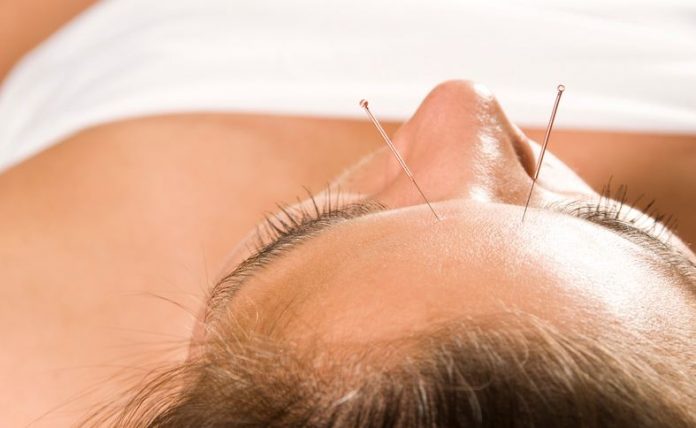Acupuncture is believed to be developed by Chinese over 2000 years ago, or may even date back as long as 5000 years. It is an important part of the Traditional Chinese Medicine (TCM).
Acupuncture is about placing fine, slender needles into the skin at certain pressure points in the body, known as acupuncture points, to help alleviate pain, relieve spasms, stimulate the immune function to promote healing, and generally improve the quality of physical, mental, and spiritual health in various ways.
The principle of acupuncture treatment is to encourage the “qi“, or the vital energy of the body, to flow smoothly in the channels, known as meridians.
The Chinese believe that qi is flowing through every living thing in the universe and it has many different forms and functions.
Within a person, qi has five major functions–warming, movement, protection, transportation and transformation, and supporting. Through these functions, the human body is able to maintain its stabilization and integrity.
The qi primarily comes from three sources. Original qi is transmitted from parents to their children. This qi is mainly responsible for the inherited constitution of a person. Grain qi is nutritive qi that is generated from diet and digestion. Natural qi is the qi we acquire through breathing. Grain qi and natural qi are mainly responsible for the body constitution after birth.
In the medical sense, when qi is out of balance, blocked, or stagnated, illness and pain result.
There are fourteen major meridians throughout the human body, including twelve primary meridians which are associated with the twelve major organ systems of the body and two extra meridians arising from genital area to the head at the center of the trunk, front and back.
There are points more than 360 acupuncture points, most fall along the fourteen meridians. Those points that do not belong to the meridians are called extra points. Extra points usually have unique and specific healing functions.
To treat illness or pain, needles are placed into these acupuncture points which correspond with the location of the disharmony of the qi.
The stimulation from needling can restore the flow of the qi and return the balance of the body system, thereby alleviate the pain and improve the symptomatic problems.
For acute cases, such as ankle sprain, a small amount of electrical current attached to the end of the acupuncture needles at certain frequency can be used to provide the points with added stimulus.
In addition to needling, the acupuncturist applies heated herbal cones or sticks above the appropriate acupuncture points , known as moxibustion, to send warmth down into the points for cold diseases.
They also use small glass or plastic cups sucked on the skin of the back, known as cupping, to draw out the toxins, resolve the stagnation, and improve the circulation at the local area.
If somebody suffers a heat stroke due to the summer heat, scraping will be used at the upper back and neck area to release the heat.
Acupuncture massage, known as tui-na, is a form of massage that focuses power on acupuncture points to relieve muscle tension and pain.
Some times the acupuncturist will use a combination of acupuncture, cupping, moxibustion, and massage as treatment protocol for individual needs.
When a patient seeks acupuncture treatment, the acupuncturist will examine him or her using four basic TCM diagnostic methods–observation, hearing, questioning, and palpation.
The acupuncturist will perform pulse and tongue diagnoses to see how well the patient is at the time of visit. The pulse and tongue diagnoses are unique to TCM. The pulse diagnosis reflects the energetics of the five vital organs, including heart, liver, lung, spleen, and kidney.
The shape, texture, and color of the tongue are indications for the dysfunctions of the vital organs and the depletion of the qi in the body.
Based on the information collected from the patient, the acupuncturist is then able to choose the best treatment methods and select points for acupuncture treatment.
General speaking, acupuncture treatment is either painless or of trivial discomfort since the needles are very fine and solid.
The patient may experience a small twinge of pain at certain acupuncture points where the skin is more sensitive to needling or the qi is more abundant, but the feeling should subside shortly after the puncture and as the treatment continues.
Acupuncture is relatively safe.
There are few side effects to the use of acupuncture reported each year. The most common side effect is bruise or soreness around the needled area.
To minimize the side effect, a trained acupuncturist will apply pressure on the needled area for 1 minute once the needle is withdrawn.
Occasionally, the patient may experience a slightly sedated feeling. This situation can be caused by an empty stomach; therefore, you need to eat at least one hour before the treatment.
Another side effect is infection. To avoid infection, you can ask the acupuncturist to use disposable needles for every treatment. If the acupuncturist does not use disposable needles, make sure the sterilization procedures are appropriate.
Acupuncture can be used to treat many illnesses, ranging from slight local pain to ascites (fluid retention in the peritoneal cavity).
Although its effectiveness is still under evaluation, acupuncture has been used in the medical field in many countries of the world.

